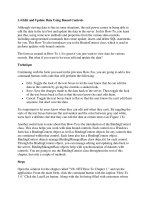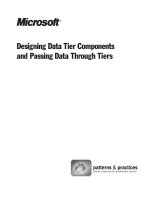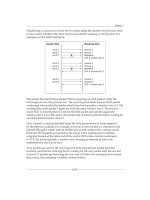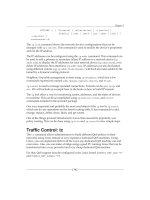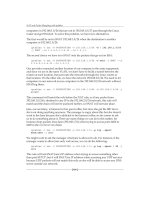Java software structures designing and using data structures international edition 4th edition
Bạn đang xem bản rút gọn của tài liệu. Xem và tải ngay bản đầy đủ của tài liệu tại đây (10.49 MB, 689 trang )
Java Software Structures
The editorial team at Pearson has worked closely with
educators around the globe to inform students of the
ever-changing world in a broad variety of disciplines.
Pearson Education offers this product to the international
market, which may or may not include alterations from the
United States version.
FOURTH
EDITION
Pearson International Edition
Lewis
Chase
This is a special edition of an established
title widely used by colleges and universities
throughout the world. Pearson published this
exclusive edition for the benefit of students
outside the United States and Canada. If you
purchased this book within the United States
or Canada you should be aware that it has
been imported without the approval of the
Publisher or Author.
INTERNATIONAL
EDITION
INTERNATIONAL
EDITION
INTERNATIONAL
EDITION
ISBN-13: 978-0-273-79332-8
ISBN-10:
0-273-79332-2
9
780273 793328
9 0 0 0 0
Java Software Structures
Designing and Using Data Structures
FOURTH EDITION
John Lewis • Joseph Chase
DESIGNING AND USING
D ATA S T R U C T U R E S
4TH EDITION
A01_LEWI3322_FM_p1-26.indd 1
21/02/13 3:45 PM
This page is intentionally left blank.
A01_LEWI3322_FM_p1-26.indd 2
21/02/13 3:45 PM
DESIGNING AND USING
D ATA S T R U C T U R E S
4TH EDITION
john Lewis
V i r g i n i a Te c h
AND
joseph chase
Radford University
International Edition contributions by
P i ya l i S e n g u p ta
Boston Columbus Indianapolis New York San Francisco
Upper Saddle River Amsterdam Cape Town Dubai London Madrid Milan
Munich Paris Montreal Toronto Delhi Mexico City Sao Paulo Sydney
Hong Kong Seoul Singapore Taipei Tokyo
A01_LEWI3322_FM_p1-26.indd 3
01/03/13 2:07 PM
Acquisitions Editor, US Edition: Matt Goldstein
Editorial Assistant: Jenah Blitz-Stoehr
Senior Managing Editor: Scott Disanno
Senior Production Supervisor: Marilyn Lloyd
Marketing Manager: Yes Alayan
Marketing Coordinator: Kathryn Ferranti
Publisher, International Edition: Angshuman Chakraborty
Publishing Administrator and Business Analyst, International
Edition: Shokhi Shah Khandelwal
Associate Print & Media Editor, International Edition:
Anuprova Dey Chowdhuri
Acquisitions Editor, International Edition: Sandhya Ghoshal
Publishing Administrator, International Edition: Hema Mehta
Project Editor, International Edition: Karthik Subramanian
Senior Manufacturing Controller, Production, International
Edition: Trudy Kimber
Marketing Coordinator: Kathryn Ferranti
Manufacturing Buyer: Lisa McDowell
Cover Design: Jodi Notowitz
Project Management and Illustrations: Cenveo® Publisher Services
Project Manager, Cenveo® Publisher Services, Inc.: Rose Kernan
Text Design, Cenveo® Publisher Services, Inc.: Jerilyn
Bockorick, Alisha Webber
Cover Image: Viachaslau Kraskouski/Shutterstock
Pearson Education Limited
Edinburgh Gate
Harlow
Essex CM20 2JE
England
and Associated Companies throughout the world
Visit us on the World Wide Web at:
www.pearsoninternationaleditions.com
© Pearson Education Limited 2014
The rights of John Lewis and Joseph Chase to be identified as authors of this work have been asserted by them in accordance
with the Copyright, Designs and Patents Act 1988.
Authorized adaptation from the United States edition, entitled Java Software Structures, 4th edition, ISBN 978-0-13-325012-1,
by John Lewis and Joseph Chase, published by Pearson Education © 2014.
All rights reserved. No part of this publication may be reproduced, stored in a retrieval system, or transmitted in any form or
by any means, electronic, mechanical, photocopying, recording or otherwise, without either the prior written permission of
the publisher or a license permitting restricted copying in the United Kingdom issued by the Copyright Licensing Agency Ltd,
Saffron House, 6–10 Kirby Street, London EC1N 8TS.
All trademarks used herein are the property of their respective owners. The use of any trademark in this text does not vest in
the author or publisher any trademark ownership rights in such trademarks, nor does the use of such trademarks imply any
affiliation with or endorsement of this book by such owners.
Microsoft and/or its respective suppliers make no representations about the suitability of the information contained in the
documents and related graphics published as part of the services for any purpose. All such documents and related graphics
are provided “as is” without warranty of any kind. Microsoft and/or its respective suppliers hereby disclaim all warranties
and conditions with regard to this information, including all warranties and conditions of merchantability, whether express,
implied or statutory, fitness for a particular purpose, title and non-infringement. In no event shall Microsoft and/or its respective
suppliers be liable for any special, indirect or consequential damages or any damages whatsoever resulting from loss of use,
data or profits, whether in an action of contract, negligence or other tortious action, arising out of or in connection with the
use or performance of information available from the services.
The documents and related graphics contained herein could include technical inaccuracies or typographical errors. Changes
are periodically added to the information herein. Microsoft and/or its respective suppliers may make improvements and/or
changes in the product(s) and/or the program(s) described herein at any time. Partial screen shots may be viewed in full within
the software version specified.
Microsoft® and Windows® are registered trademarks of the Microsoft Corporation in the U.S.A. and other countries. This
book is not sponsored or endorsed by or affiliated with the Microsoft Corporation.
ISBN 10: 0-273-79332-2
ISBN 13: 978-0-273-79332-8 (Print)
ISBN 13: 978-0-273-79368-7 (PDF)
British Library Cataloguing-in-Publication Data
A catalogue record for this book is available from the British Library
10 9 8 7 6 5 4 3 2 1
14 13 12 11 10
Typeset in Sabon LT Std Roman by Cenveo® Publisher Services
Printed and bound by Courier Westford in The United States of America
The publisher’s policy is to use paper manufactured from sustainable forests.
A01_LEWI3322_FM_p1-26.indd 4
01/03/13 2:07 PM
To my wife Sharon and my kids:
Justin, Kayla, Nathan, and Samantha
–J. L.
To my loving wife Melissa for her support and encouragement
and to our families, friends, colleagues, and students who have provided
so much support and inspiration through the years.
–J. C.
A01_LEWI3322_FM_p1-26.indd 5
21/02/13 3:45 PM
This page is intentionally left blank.
A01_LEWI3322_FM_p1-26.indd 6
21/02/13 3:45 PM
Preface
This book is designed to serve as a text for a course on data structures and algorithms. This course is typically referred to as the CS2 course because it is often
taken as the second course in a computing curriculum.
Pedagogically, this book follows the style and approach of the leading CS1
book Java Software Solutions: Foundations of Program Design, by John Lewis
and William Loftus. Our book uses many of the highly regarded features of that
book, such as the Key Concept boxes and complete code examples. Together,
these two books support a solid and consistent approach to either a two-course or
three-course introductory sequence for computing students. That said, this book
does not assume that students have used Java Software Solutions in a previous
course.
Material that might be presented in either course (such as recursion or sorting) is presented in this book as well. We also include strong reference material
providing an overview of object-oriented concepts and how they are realized in
Java.
We understand the crucial role that the data structures and algorithms course
plays in a curriculum and we think this book serves the needs of that course
well.
New in the Fourth Edition
We have made some key modifications in this fourth edition to enhance its pedagogy. They can be summarized as follows:
n
n
n
n
Revised the collection chapters to provide a more complete explanation of
how the Java API supports the collection.
Added a summary of terms and definitions at the end of each chapter.
Separated the coverage of Iterators into it’s own chapter and expanded the
discussion.
Added a new Code Annotation feature, used to explore key statements
with graphic annotations.
n
Added a new Common Error callout feature.
n
Added new Design Focus callouts.
7
A01_LEWI3322_FM_p1-26.indd 7
21/02/13 3:45 PM
8
Prefa ce
n
n
Added a new appendices covering graphical drawing, graphical user interface development, and regular expressions.
Reviewed and updated the text throughout to improve discussions and address issues.
In particular, we’ve reworked the discussion of individual collections to match
the following flow:
Explore the collection conceptually.
Discuss the support in the
Java API for the collection.
Use the collection to solve problems.
Explore implementation options
and efficiency issues.
This approach clarifies the distinction between the way the Java API supports a
particular collection and the way it might be implemented from scratch. It makes
it easier for instructors to point out limitations of the API implementations in a
compare-and-contrast fashion. This approach also allows an instructor, on a caseby-case basis, to simply introduce a collection without exploring implementation
details if desired.
The other modifications for this edition flesh out the presentation to a higher
degree than previous editions did. The addition of a term list (with succinct definitions) at the end of each chapter provides a summary of core issues in ways
that the other features don’t. New Code Annotation and Common Error features
highlight specific issues that might otherwise get lost in the body of the text, but
without interrupting the flow of the topic.
We think these modifications build upon the strong pedagogy established by
previous editions and give instructors more opportunity and flexibility to cover
topics as they choose.
Our Approach
Books of this type vary greatly in their overall approach. Our approach is founded
on a few important principles that we fervently embraced. First, we present the
various collections explored in the book in a consistent manner. Second, we
A01_LEWI3322_FM_p1-26.indd 8
21/02/13 3:45 PM
P refa c e
9
emphasize the importance of sound software design techniques. Third, we organized the book to support and reinforce the big picture: the study of data structures and algorithms.
Throughout the book, we keep sound software engineering practices a high
priority. Our design of collection implementations and the programs that use them
follow consistent and appropriate standards.
Of primary importance is the separation of a collection’s interface from its
underlying implementation. The services that a collection provides are always
formally defined in a Java interface. The interface name is used as the type designation of the collection whenever appropriate to reinforce the collection as an
abstraction.
Chapter Breakdown
Chapter 1 (Introduction) discusses various aspects of software quality and
provides an overview of software development issues. It is designed to establish
the appropriate mindset before embarking on the details of data structure and
algorithm design.
Chapter 2 (Analysis of Algorithms) lays the foundation for determining the
efficiency of an algorithm and explains the important criteria that allow a developer to compare one algorithm to another in proper ways. Our emphasis in this
chapter is understanding the important concepts more than getting mired in heavy
math or formality.
Chapter 3 (Introduction to Collections—Stacks) establishes the concept of a
collection, stressing the need to separate the interface from the implementation.
It also conceptually introduces a stack, then explores an array-based implementation of a stack.
Chapter 4 (Linked Structures—Stacks) discusses the use of references to create
linked data structures. It explores the basic issues regarding the management of
linked lists, and then defines an alternative implementation of a stack (introduced
in Chapter 3) using an underlying linked data structure.
Chapter 5 (Queues) explores the concept and implementation of a first-in, firstout queue. Radix sort is discussed as an example of using queues effectively. The
implementation options covered include an underlying linked list as well as both
fixed and circular arrays.
Chapter 6 (Lists) covers three types of lists: ordered, unordered, and indexed.
These three types of lists are compared and contrasted, with discussion of the
operations that they share and those that are unique to each type. Inheritance
is used appropriately in the design of the various types of lists, which are implemented using both array-based and linked representations.
A01_LEWI3322_FM_p1-26.indd 9
21/02/13 3:45 PM
10
Prefa ce
Chapter 7 (Iterators) is a new chapter that isolates the concepts and implementation of iterators, which are so important to collections. The expanded discussion
drives home the need to separate the iterator functionality from the details of any
particular collection.
Chapter 8 (Recursion) is a general introduction to the concept of recursion and
how recursive solutions can be elegant. It explores the implementation details of
recursion and discusses the basic idea of analyzing recursive algorithms.
Chapter 9 (Searching and Sorting) discusses the linear and binary search algorithms, as well as the algorithms for several sorts: selection sort, insertion sort,
bubble sort, quick sort, and merge sort. Programming issues related to searching
and sorting, such as using the Comparable interface as the basis of comparing
objects, are stressed in this chapter. Searching and sorting that are based in particular data structures (such as heap sort) are covered in the appropriate chapter
later in the book.
Chapter 10 (Trees) provides an overview of trees, establishing key terminology
and concepts. It discusses various implementation approaches and uses a binary
tree to represent and evaluate an arithmetic expression.
Chapter 11 (Binary Search Trees) builds off of the basic concepts established
in Chapter 10 to define a classic binary search tree. A linked implementation of a
binary search tree is examined, followed by a discussion of how the balance in the
tree nodes is key to its performance. That leads to exploring AVL and red/black
implementations of binary search trees.
Chapter 12 (Heaps and Priority Queues) explores the concept, use, and implementations of heaps and specifically their relationship to priority queues. A heap
sort is used as an example of its usefulness as well. Both linked and array-based
implementations are explored.
Chapter 13 (Sets and Maps) explores these two types of collections and their
importance to the Java Collections API.
Chapter 14 (Multi-way Search Trees)is a natural extension of the discussion of
the previous chapters. The concepts of 2-3 trees, 2-4 trees, and general B-trees are
examined and implementation options are discussed.
Chapter 15 (Graphs) explores the concept of undirected and directed graphs
and establishes important terminology. It examines several common graph algorithms and discusses implementation options, including adjacency matrices.
Appendix A (UML) provides an introduction to the Unified Modeling
Language as a reference. UML is the de facto standard notation for representing
object-oriented systems.
Appendix B (Object-Oriented Concepts) is a reference for anyone needing a
review of fundamental object-oriented concepts and how they are accomplished
A01_LEWI3322_FM_p1-26.indd 10
21/02/13 3:45 PM
P refa c e
11
in Java. Included are the concepts of abstraction, classes, encapsulation, inheritance, and polymorphism, as well as many related Java language constructs such
as interfaces.
Appendix C (Graphics) covers the basics of drawing shapes using the Java API.
Appendix D (Graphical User Interfaces) provides a detailed overview of the
elements needed to develop a Swing-based GUI. It includes many examples using
a variety of interface components.
Appendix E (Hashing) covers the concept of hashing and related issues, such
as hash functions and collisions. Various Java Collections API options for hashing
are discussed.
Appendix F (Regular Expressions) provides an introduction to the use of regular expressions, which come into play in various Java API elements, such as the
Scanner class.
Supplements
The following student resources are available for this book:
n
Source code for all programs presented in the book
n
VideoNotes that explore select topics from the book
Resources can be accessed at www.pearsoninternationaleditions.com/lewis
The following instructor resources can be found at Pearson Education’s
Instructor Resource Center:
n
Solutions for select exercises and programming projects in the book
n
Powerpoint slides for the presentation of the book content
n
Test bank
To obtain access, please visit www.pearsoninternationaleditions.com/lewis
or contact your local Pearson Education sales representative.
Pearson would also like to thank Mohit P. Tahiliani of NITK Surathkal for
reviewing the content of the International Edition.
A01_LEWI3322_FM_p1-26.indd 11
21/02/13 3:45 PM
This page is intentionally left blank.
A01_LEWI3322_FM_p1-26.indd 12
21/02/13 3:45 PM
Contents
Preface
7
Credits
25
Chapter 1
27
Introduction
1.1
Software Quality
Correctness
Reliability
Robustness
Usability
Maintainability
Reusability
Portability
Efficiency
Quality Issues
28
29
29
30
30
31
31
32
32
32
1.2
Data Structures
A Physical Example
Containers as Objects
33
33
36
Chapter 2Analysis of Algorithms
41
2.1Algorithm Efficiency
42
2.2
43
Growth Functions and Big-Oh Notation
2.3Comparing Growth Functions
45
2.4
48
48
48
49
Determining Time Complexity
Analyzing Loop Execution
Nested Loops
Method Calls
13
A01_LEWI3322_FM_p1-26.indd 13
21/02/13 3:45 PM
14
Contents
Chapter 3
Introduction to Collections – Stacks
55
3.1Collections
Abstract Data Types
The Java Collections API
56
57
59
3.2A Stack Collection
59
3.3Crucial OO Concepts
61
62
Inheritance and Polymorphism
Generics63
3.4
Chapter 4
A01_LEWI3322_FM_p1-26.indd 14
Using Stacks: Evaluating Postfix Expressions
64
Javadoc71
3.5Exceptions
72
3.6A Stack ADT
74
3.7
Implementing a Stack: With Arrays
Managing Capacity
77
78
3.8
The ArrayStack Class
The Constructors
The push Operation
The pop Operation
The peek Operation
Other Operations
The EmptyCollectionException Class
Other Implementations
79
80
82
83
85
85
85
86
Linked Structures – Stacks
93
4.1References as Links
94
4.2
Managing Linked Lists
Accessing Elements
Inserting Nodes
Deleting Nodes
96
96
97
98
4.3
Elements without Links
Doubly Linked Lists
99
99
4.4
Stacks in the Java API
100
21/02/13 3:45 PM
Chapter 5
Chapter 6
Contents
4.5
Using Stacks: Traversing a Maze
101
4.6
Implementing a Stack: With Links
The LinkedStack Class
The push Operation
The pop Operation
Other Operations
110
110
114
116
117
Queues
124
5.2
Queues in the Java API
125
5.3
Using Queues: Code Keys
126
5.4
Using Queues: Ticket Counter Simulation
130
5.5A Queue ADT
135
5.6A Linked Implementation of a Queue
The enqueue Operation
The dequeue Operation
Other Operations
137
139
141
142
5.7
Implementing Queues: With Arrays
The enqueue Operation
The dequeue Operation
Other Operations
143
147
149
150
5.8
Double-Ended Queues (Deque)
150
155
6.1A List Collection
156
6.2
Lists in the Java Collections API
158
6.3
Using Unordered Lists: Program of Study
159
6.4
Using Indexed Lists: Josephus
170
6.5A List ADT
Adding Elements to a List
A01_LEWI3322_FM_p1-26.indd 15
123
5.1A Conceptual Queue
Lists
15
172
173
21/02/13 3:45 PM
16
Contents
Chapter 7
6.6
Implementing Lists with Arrays
178
The remove Operation
180
The contains Operation
182
The add Operation for an Ordered List
183
Operations Particular to Unordered Lists
185
The addAfter Operation for an Unordered List 185
6.7
Implementing Lists with Links
The remove Operation
Iterators
What’s an Iterator?
Other Iterator Issues
196
198
7.2
Using Iterators: Program of Study Revisited
Printing Certain Courses
Removing Courses
198
202
203
7.3
Implementing Iterators: With Arrays
205
7.4
Implementing Iterators: With Links
207
213
8.1Recursive Thinking
Infinite Recursion
Recursion in Math
214
214
215
8.2Recursive Programming
Recursion versus Iteration
Direct versus Indirect Recursion
216
219
219
8.3
220
220
228
Using Recursion
Traversing a Maze
The Towers of Hanoi
8.4Analyzing Recursive Algorithms
Searching and Sorting
9.1Searching
Static Methods
Generic Methods
A01_LEWI3322_FM_p1-26.indd 16
195
7.1
Chapter 8Recursion
Chapter 9
186
187
233
241
242
243
243
21/02/13 3:45 PM
Contents
Linear Search
Binary Search
Comparing Search Algorithms
244
246
248
9.2Sorting
Selection Sort
Insertion Sort
Bubble Sort
Quick Sort
Merge Sort
249
252
254
256
258
262
9.3Radix Sort
265
Chapter 10 Trees
275
10.1Trees
Tree Classifications
276
277
10.2 Strategies for Implementing Trees
Computational Strategy for Array
Implementation of Trees
Simulated Link Strategy for Array
Implementation of Trees
Analysis of Trees
279
10.3 Tree Traversals
Preorder Traversal
Inorder Traversal
Postorder Traversal
Level-Order Traversal
282
282
283
283
284
10.4A Binary Tree ADT
285
10.5 Using Binary Trees: Expression Trees
289
10.6A Back Pain Analyzer
301
10.7 Implementing Binary Trees with Links
The find Method
The iteratorInOrder Method
305
310
312
279
279
281
Chapter 11 Binary Search Trees
319
11.1A Binary Search Tree
320
A01_LEWI3322_FM_p1-26.indd 17
17
21/02/13 3:45 PM
18
Contents
11.2 Implementing Binary Search Trees: With Links
The addElement Operation
The removeElement Operation
The removeAllOccurrences Operation
The removeMin Operation
Implementing Binary Search Trees: With Arrays
322
323
326
329
330
332
11.3 Using Binary Search Trees: Implementing
Ordered Lists
332
Analysis of the BinarySearchTreeList
Implementation335
11.4 Balanced Binary Search Trees
Right Rotation
Left Rotation
Rightleft Rotation
Leftright Rotation
336
337
338
339
339
11.5 Implementing BSTs: AVL Trees
Right Rotation in an AVL Tree
Left Rotation in an AVL Tree
Rightleft Rotation in an AVL Tree
Leftright Rotation in an AVL Tree
340
341
341
341
343
11.6 Implementing BSTs: Red/Black Trees
Insertion into a Red/Black Tree
Element Removal from a Red/Black Tree
343
344
347
Chapter 12 Heaps and Priority Queues
A01_LEWI3322_FM_p1-26.indd 18
357
12.1A Heap
The addElement Operation
The removeMin Operation
The findMin Operation
358
360
361
362
12.2 Using Heaps: Priority Queues
362
12.3 Implementing Heaps: With Links
The addElement Operation
The removeMin Operation
The findMin Operation
366
368
370
373
21/02/13 3:45 PM
Contents
12.4 Implementing Heaps: With Arrays
The addElement Operation
The removeMin Operation
The findMin Operation
12.5 Using Heaps: Heap Sort
Chapter 13 Sets and Maps
373
375
376
378
378
385
13.1 Set and Map Collections
386
13.2 Sets and Maps in the Java API
386
13.3 Using Sets: Domain Blocker
389
13.4 Using Maps: Product Sales
392
13.5 Using Maps: User Management
396
13.6 Implementing Sets and Maps Using Trees
401
13.7 Implementing Sets and Maps Using Hashing
401
Chapter 14 Multi-Way Search Trees
19
409
14.1Combining Tree Concepts
410
14.2 2-3 Trees
Inserting Elements into a 2-3 Tree
Removing Elements from a 2-3 Tree
410
411
413
14.3 2-4 Trees
416
14.4B-Trees
418
B*-Trees419
B+-Trees419
Analysis of B-Trees
420
14.5 Implementation Strategies for B-Trees
Chapter 15 Graphs
A01_LEWI3322_FM_p1-26.indd 19
420
427
15.1 Undirected Graphs
428
15.2 Directed Graphs
429
21/02/13 3:45 PM
20
Contents
15.3Networks
431
15.4Common Graph Algorithms
432
Traversals432
Testing for Connectivity
436
Minimum Spanning Trees
438
Determining the Shortest Path
441
15.5 Strategies for Implementing Graphs
Adjacency Lists
Adjacency Matrices
441
442
442
15.6 Implementing Undirected Graphs with
an Adjacency Matrix
The addEdge Method
The addVertex Method
The expandCapacity Method
Other Methods
443
448
448
449
450
Appendix A UML
The Unified Modeling Language (UML)
456
UML Class Diagrams
456
UML Relationships
458
Appendix B Object-Oriented Design
463
B.1
Overview of Object-Orientation
B.2
Using Objects
464
Abstraction465
Creating Objects
466
464
B.3Class Libraries and Packages
The import Declaration
468
468
B.4
469
State and Behavior
B.5Classes
Instance Data
A01_LEWI3322_FM_p1-26.indd 20
455
470
473
21/02/13 3:45 PM
Contents
B.6 Encapsulation
Visibility Modifiers
Local Data
474
474
476
B.7Constructors
476
B.8
477
Method Overloading
21
B.9References Revisited
478
The Null Reference
478
The this Reference
479
Aliases481
Garbage Collection
482
Passing Objects as Parameters
483
A01_LEWI3322_FM_p1-26.indd 21
B.10 The static Modifier
Static Variables
Static Methods
483
484
484
B.11 Wrapper Classes
485
B.12Interfaces
The Comparable Interface
486
487
B.13Inheritance
Derived Classes
The protected Modifier
The super Reference
Overriding Methods
488
488
490
491
491
B.14Class Hierarchies
The Object Class
Abstract Classes
Interface Hierarchies
492
493
494
496
B.15Polymorphism
References and Class Hierarchies
Polymorphism via Inheritance
Polymorphism via Interfaces
496
497
498
498
B.16Exceptions
Exception Messages
The try Statement
Exception Propagation
The Exception Class Hierarchy
501
502
502
503
504
21/02/13 3:45 PM
22
Contents
Appendix C Java Graphics
C.1
Pixels and Coordinates
516
C.2Representing Color
517
C.3
Drawing Shapes
518
C.4
Polygons and Polylines
The Polygon Class
527
530
Appendix D Graphical User Interfaces
A01_LEWI3322_FM_p1-26.indd 22
515
537
D.1
GUI Elements
Frames and Panels
Buttons and Action Events
Determining Event Sources
538
539
543
545
D.2
More Components
548
Text Fields
548
Check Boxes
551
Radio Buttons
555
Sliders559
Combo Boxes
564
Timers569
D.3
Layout Managers
Flow Layout
Border Layout
Grid Layout
Box Layout
Containment Hierarchies
574
576
579
583
586
589
D.4
Mouse and Key Events
Mouse Events
Key Events
Extending Adapter Classes
589
589
598
604
D.5
Dialog Boxes
File Choosers
Color Choosers
605
608
611
21/02/13 3:45 PM
Contents
D.6
Some Important Details
612
Borders612
Tool Tips and Mnemonics
616
D.7
GUI Design
Appendix E Hashing
623
633
E.1 Hashing
634
E.2
636
636
637
637
638
638
638
639
Hashing Functions
The Division Method
The Folding Method
The Mid-Square Method
The Radix Transformation Method
The Digit Analysis Method
The Length-Dependent Method
Hashing Functions in the Java Language
23
E.3Resolving Collisions
639
Chaining639
Open Addressing
642
E.4
Deleting Elements from a Hash Table
646
Deleting from a Chained Implementation
646
Deleting from an Open Addressing
Implementation647
E.5
Hash Tables in the Java Collections API
648
The Hashtable Class
648
The HashSet Class
650
The HashMap Class
650
The IdentityHashMap Class
651
The WeakHashMap Class
652
LinkedHashSet and LinkedHashMap653
Appendix FRegular Expressions
661
Index
665
A01_LEWI3322_FM_p1-26.indd 23
21/02/13 3:45 PM
LOCATION OF VIDEONOTES IN THE TEXT
VideoNote
Chapter 3 An overview of the ArrayStack implementation, page 80
Chapter 4 Using a stack to solve a maze, page 103
Chapter 5 An array-based queue implementation, page 143
Chapter 6 List categories, page 156
Chapter 8 Analyzing recursive algorithms, page 234
Chapter 9 Demonstration of a binary search, page 247
Chapter 10 Demonstration of the four basic tree traversals, page 285
Chapter 11 Demonstration of the four basic tree rotations, page 340
Chapter 12 Demonstration of a heap sort on an array, page 379
Chapter 14 Inserting elements into, and removing elements from, a 2-3 tree, page 414
Chapter 15 Illustration of depth-first and breadth-first traversals of a graph, page 433
A01_LEWI3322_FM_p1-26.indd 24
21/02/13 3:45 PM


